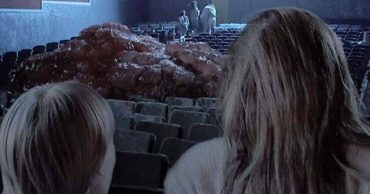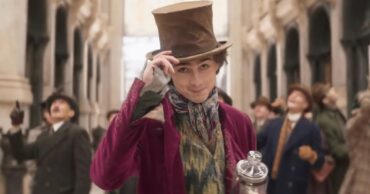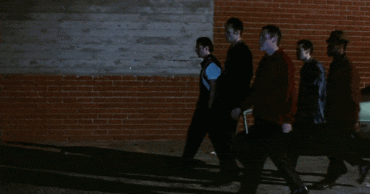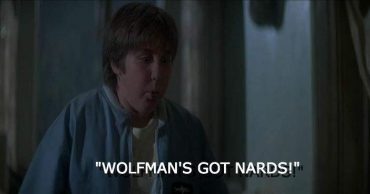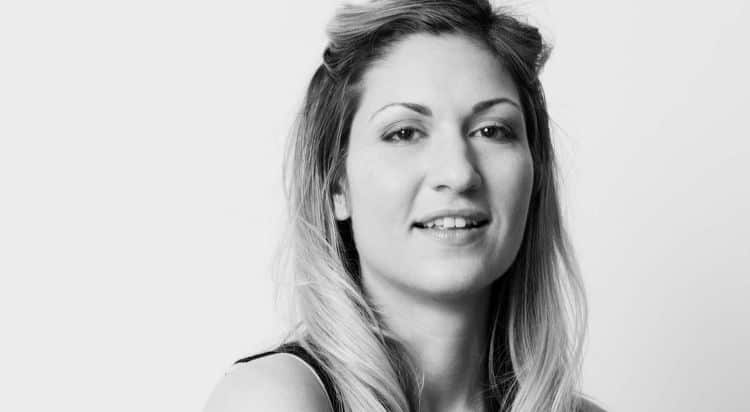
In honor of Momentum Pictures recent release of Witch Hunt, we spoke with the film’s production designer, Holly Trotta. Below she answers ten questions about her work on the film and other projects.
-What made you want to become a production designer?
While studying at the School of Visual Arts in New York City, I focused on a career in Art Direction. From my experience working at various entertainment companies like VH1, MTV and Atlantic Records, I always knew I wanted to pursue a career in entertainment. I found out early I didn’t want to be sitting behind a computer creating. I’m a very tactile person. Having the opportunity to not only create behind a computer, but physically be involved in building the look and feel of the subject matter I was designing, was something I immediately gravitated towards. It was a natural progression for me. Looking back, everything I had learned would play an intricate role in what I do today.
I started freelancing at Atlantic Records in the Creative Department as an Art Director. Our department had close ties with the Video Content Department and there was a lot of crossovers between the two. I was working on a music video for the Hip Hop artist, T.I. One of the other Art Directors told me he had a “little arts and crafts” project. This was more like a small production design project now that I look back at it. I was tasked to create a three-dimensional map one would see in a crime movie to identify the movement of suspects and their associates involved in a crime across the US. This was my launching point. As I dove into a bit of research, I realized it’s someone’s job to create the look and feel of all the backgrounds you see in movies, TV shows, commercials, and music videos.
From there I started designing more art-heavy music videos. I also began working with other designers in high-end fashion photography. I became obsessed with the art of making an image. This was just the beginning. I wanted to, not only create a moment through a still image, but expand larger into creating the “world” they lived in through motion.
-For people that might not know, what are some of your duties as a production designer?
The roll of a Production Designer, also known as an Art Director, is to establish the overall look and feel within a film, TV show, commercial or music video. Production Designers are essentially designing the entire background the talent on camera lives in, from any picture vehicles to furniture and special effects. They oversee designing it all. This role is a department-head position and works closely with a team to execute the Director’s vision.
It’s not all about the visuals though. You are also playing a numbers game to make sure you can execute with the money provided in your budget. You work closely with the line producer to make sure your vision and the funds are properly managed from start to finish. Being a production designer is probably one of the most rigorous positions on a set. There are so many crossovers your department has into other departments, from costumes, to Grip & Electric, lighting and more. I think that’s the beauty of being in this position. You get to work with so many different people and their specialized crafts to make the entire machine run and, in the end, are creating what you see on camera.
-What are you most proud of when it comes to Witch Hunt?
I’m proud of what we were able to accomplish on a limited budget. It’s always a challenge to execute a stylized film when the vision you have, and the funds associated, don’t necessarily align. One must compromise without sacrificing too much of the storyline and your vision of that storyline. There were many changes that needed to be made even after I received the script, due to the budgetary constraints. There were also a couple sets that needed to be built. Building sets always comes at a cost. Many people think it’s cheaper to build than it is. You must be creative in the way you keep the cost down. I was proud in the way the film turned out and was excited to hear it was premiering at SXSW.
-Did you learn anything from working on Witch Hunt?
I love working with the Stunt Department and continue to learn how their needs crossover into my department. I learned a lot when it came to shooting and working with water which is an interest of mine. I also learned what it takes for someone to jump or fall off the roof of a building. Although it doesn’t directly fall into Art Department, it important to carry all the knowledge of what it takes to accomplish these stunts into future projects. Having this experience helps in many ways from location scouting, to sourcing and dressing spaces. One needs to know specific parameters the stunt team is working in, which affects the Art Department in many ways. When reading a script, early on in preproduction, you can more easily look out for specifics the stunt team may need.
-You worked on Phobias, what was the most challenging set on that film?
I don’t think there was a particular set that was more challenging than the other. More so was the challenge of working on a smaller budget film and having so many locations we were dressing. My department was comprised of six people including myself and we were flipping sets daily on this film. Working on this scale is less conventional in the sense we had to have an all-hand on deck approach. This approach is much different than larger budget films, where each person has a designated role within the Art Department and can focus on their specific job. A job-specific approach makes the whole team function in an organized streamline manner. I tried my best to keep everyone compartmentalized, but sometimes there had to be crossover due to the volume of work that needed to be done. What was also a challenge was re-adjusting back to a normal schedule after working mostly nights for the duration of filming. I would say ninety percent of the movie was shot at night. After filming this way for such a long period, my body took some time to re-acclimate.
-You worked on a lot of music videos with Melanie Martinez. How did you get connected with her?
I was introduced to Melanie Martinez shortly after leaving Atlantic Records to focus full-time on a career as a Production Designer. I kept in close contact with the Video Content Department at Atlantic and would often visit friends still at the label. One day I was talking to a producer there about the work I was interested in doing and they mentioned a project with her. I was immediately interested. Her esthetic and mine were very similar. We connected after our first project, and I continued to work close with her on the visual side of the stories she was trying to tell through her music.
I love working on music videos with passionate musicians. It’s different than commercial work and is like working on a film where you are evoking a look and feel. Most of the time you are recreating a mood the artist wants to live in. The mood can be weird and funky or abstract and surreal. One doesn’t need to have a specific reason to incorporate certain elements into the set. It’s fun to work from this place and you can flex more creativity.
-You worked on Mortal Kombat 11: What Would You Fight For. Were you familiar with the Mortal Kombat world before working on this? If not, what did you do to familiarize yourself with that franchise?
I was familiar with Mortal Kombat before working on this project. It’s a classic movie. The new remake is fantastic as well. I had worked with the Director, Joe Sill, and the Director of Photography, Nico Aguilar, many times before so knew this project was going to be a fun one. I love special effects. They’re probably one of my favorite things to incorporate in my sets. Anything to do with the 4 elements of earth (earth, air, fire, and water), I go crazy for. Dark, damp, hazy decaying buildings are so up my alley. I gravitate towards this type of work because there is so much character in places like this. I am intrigued by the space. There is a sense of mystery to how a place got to this point. This was a project of passion for me. We wanted to create a modern-day spin to advertise the video game while incorporating similar concepts and themes into the movie. It’s still a favorite project to date.
-Is there anyone in particular that you look up to in the production design world? What project made you take notice of him/her?
Deborah Riley’s work on the Game of Thrones was extremely impressive. I was blown away with the level of detail and artistry that went into so many of the sets and the scale of each.
Eugenio Caballero and his work on Pan’s Labyrinth I admire. I absolutely loved the visuals that aided in the story’s dark fantasy, especially parts of the Labyrinth. I’ve always been inspired by how the earth naturally forms parts of its geography such as caves, forests, underground caverns among many others, and how they can be recreated into sets.
Patricio Farrell’s work on the Haunting of Hill House was noteworthy as well. When flashbacks occurred in the house throughout the film, I was impressed in what the Art Department was able to do in flipping the house from clean, warm, and lived in to abandon, old and decaying. It’s something I’m looking to do more of in future work.
-How would you describe your personal style?
My personal style is a bit eclectic. From the type of furniture I like to the clothing I wear. I have many different looks. It changes depending on my mood and the day. I have a similar approach in this mentality when it comes to my home. I’m always moving things around to change it up so if feels different. I draw a lot of inspiration from the 1970’s, and if I could live in any time-period, the 70’s would be it. There was so much going on in that decade. The rebellious music, rise of Rock and Roll, style of interiors and furniture, and fashion popular at the time, will continue to be an inspiration to me, not to mention the historical moments that happened.
I’m a big fan of the color black, graphic bold prints and gravitate towards statement pieces, whether a coat (new or vintage), or an old piece of pawn jewelry. I also lean towards the concept of layering. It creates depth in anything you are looking at from a room to what someone is wearing.
As far as the arts, I love larger than life pop-art and surrealism. When I lived in Brooklyn, NY, I would spend my free days at the Museum of Modern Art. I was inspired by the photography, fine art and ready-made collections housed there. I’m also a big fan of Art Deco, antique brass, and deep rich colors.
-What types of projects do you see yourself working on in five years?
I see myself working on bigger budget narrative films in the future. I would love to work with Blum House on some of their horror films. I have a love for good horror. I don’t think that will ever go away but I would like to also branch out into working on Sci-Fi fantasy and psychological thrillers. I also see myself traveling more for work. It’s always exciting to see new places and film in locations you haven’t been to before. I love learning about the culture of different areas and nothing beats being there firsthand. I want to continue being involved with more stylized work as it’s a place I get to be extremely creative.
 Follow Us
Follow Us
